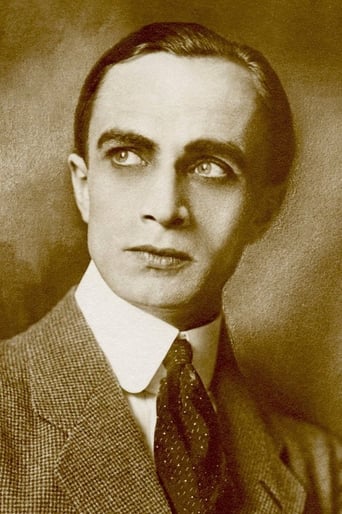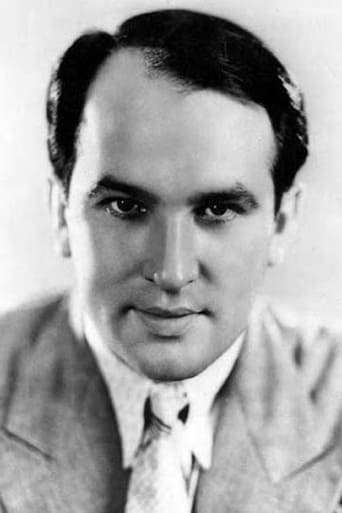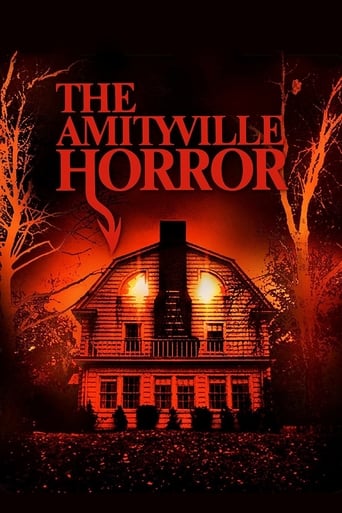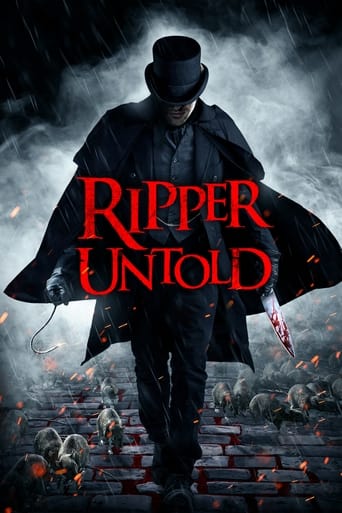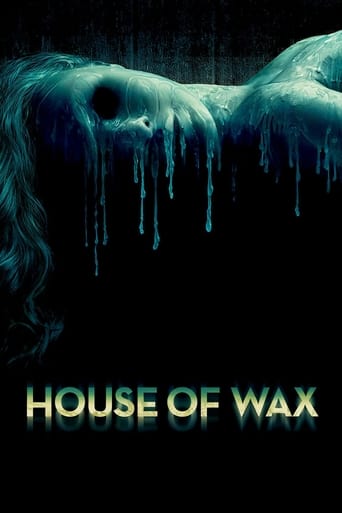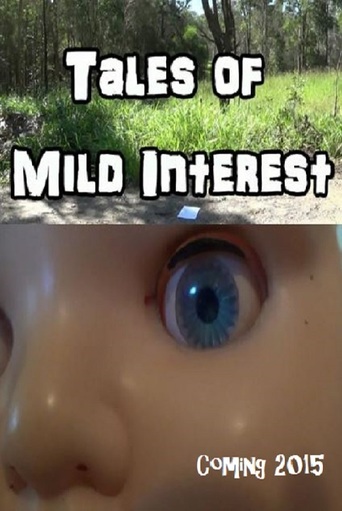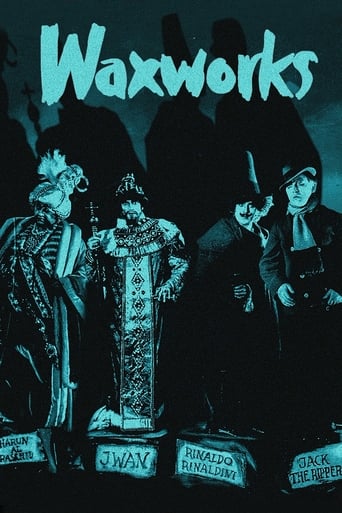
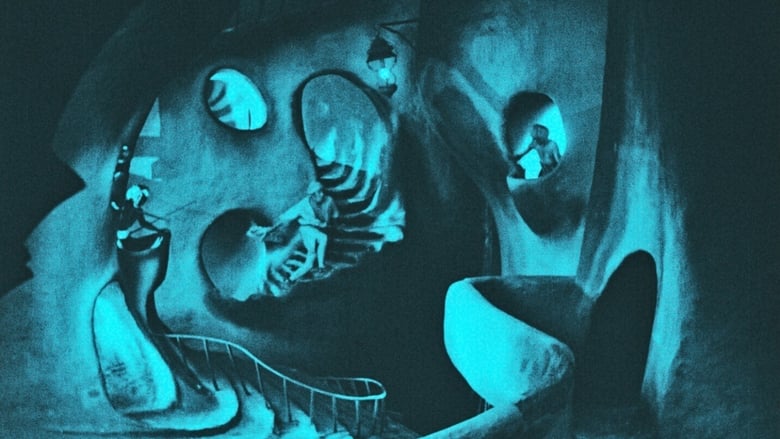
Waxworks (1926)
A poet is hired by the owner of a wax museum in a circus to write tales about Harun al Raschid, Ivan the Terrible and Jack the Ripper. While writing, the poet and the daughter of the owner, Eva, fantasize the fantastic stories and fall in love for each other.
Watch Trailer
Cast
Similar titles
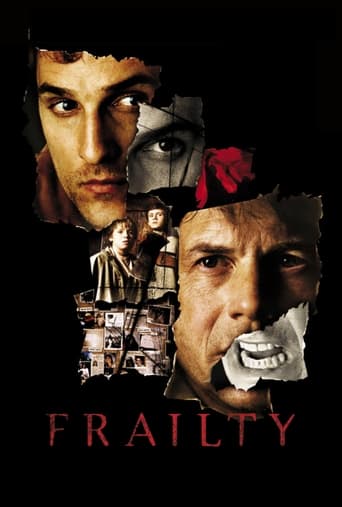
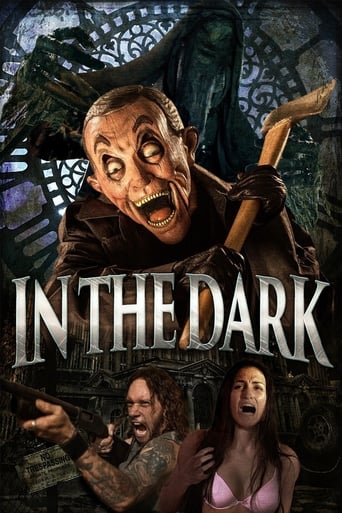
Reviews
I'll tell you why so serious
It's entirely possible that sending the audience out feeling lousy was intentional
The best films of this genre always show a path and provide a takeaway for being a better person.
An old-fashioned movie made with new-fashioned finesse.
A poet is hired by the owner of a wax museum in a circus to write tales about Harun al Raschid, Ivan the Terrible and Jack the Ripper. While writing, the poet and the daughter of the owner, Eva, fantasize the fantastic stories and fall in love with each other.Director Paul Leni tells three stories, with the great German actors Emil Jannings ("Last Laugh"), Werner Krauss ("Cabinet of Dr. Caligari") and Conrad Veidt ("Caligari") playing their roles. With this cast and director, you should expect greatness. Personally, I did not find it as great as it could have been, but this may be because I was expecting a horror film and because the film's quality was not what it could be.Kino deserves a lot of credit for releasing this film, especially considering that they had to mix two different sources. The unfortunate part is how pixelated the film is. Even on a medium-sized TV, the squares are evident. Maybe this is unavoidable, but it does make the transfer look cheap. (To be fair, the version I saw in the theater looked no better.)I am tempted to complain about historical accuracy, but I will not. I hope people know that Ivan the Terrible did not get obsessed with an hour glass and that Jack the Ripper never killed men. But, heck, who knows? I will say this: if you watch the film in a theater (which is quite a treat), the only way to do this is with live organ accompaniment. Please watch it like that, otherwise just rent or buy it. The Kino version comes with a nice Paul Leni short.And keep in mind how influential this film was. All wax museum films can be traced back to it, and it is widely believed that "Thief of Baghdad" took its inspiration from this film.
Usually in these Wax horrors, it's the notion of a life entombed in the body that is meant to unsettle, a life extended even into death (or is it the opposite?). This is the first of these films as far as I know - later came the two Houses of Wax, another Waxwork in '88, the Italian Wax Mask from an Argento story - and so the notion is more outdated, more novelistic. Each life a separate story and world, with clear boundaries between them, and acted out by the same couple that writes the stories back in the level of reality.In Baghdad we get a romantic adventure where the Caliph falls for the baker's girl. Eventually she restores balance by summoning the dead Caliph from beyond the grave for the eyes of his awe-struck vassals. It's a ploy by which the status quo of the Arabian nights is maintained. In Czarist Russia, the cruel czar who thought he would defy even death is faced with his own mortality. Instead of accepting this common fate, thus coming to understand that a king is also a common man and in so doing be rendered free of his own despotic bonds, he goes mad. It's again a ploy, the poison-maker's vengeance from beyond the grave. But he was mad to begin with, so it doesn't quite matter.The final story that blends back into the wrap-around and brings us full circle, is about a notorious killer who stalks a man and his girl. This is the segment that strikes some spark; the urbane setting diffused as dreamy, expressionist poem. It's again a ploy, this time a dream - or nightmare.Both Emil Jannings and Conrad Veidt, stars of what was then a booming film industry, relish the opportunity of playing scheming tyrants. But it's all harmless stuff.
As it happens, this is yet another faux horror film from director Paul Leni - but, then, it's mentioned in every book on the genre I have, so this common misconception has probably more to do with the authors than with the films themselves having been sold back in the day as such! Anyway, this factor had certainly marked my initial viewing of the film - which, again, I had found rather disappointing; a second look reaps rewards in that it can be taken for what it is - and not for what it's been played up to be over the years! That said, the film started cinema's macabre interest in wax museums which, by and large, endures to this day... The premise itself is undeniably interesting: a young writer is asked to concoct blood-curdling tales about famous historical figures (we're not told what they are for, but I'd assume that the fairground owner would relate these tales on a stage to draw the crowds in). Initially it was intended to be a four-part film with the characters being Caliph Haroun-al-Raschid, Czar Ivan "The Terrible", Jack The Ripper (dubbed "Spring-Heeled Jack"!; is that how the notorious serial killer was known in the U.S.?) and highwayman Rinaldo Rinaldini; eventually, the whole section relating to the latter was dropped (but I'm curious to know who had been cast in this role - his wax figure is still visible in the linking narrative, but I couldn't discern the 'actor' whom it was supposed to look like!).The Haroun-al-Raschid episode is the first, longest and least 'horrific': in fact, it's outright comedy for the most part, with Emil Jannings' obese and perennially grimacing Caliph flirting with the beautiful wife (Olga Belaieff) of poor but jealous baker Wilhelm Dieterle; the latter, meanwhile, is scolded by the girl for their poverty and colorless lifestyle - so he contrives to break into the Caliph's palace and steal his "wishing ring". What he doesn't know is that the figure in the Caliph's bed is made of wax: he cuts the hand and takes it to his wife (who is concealing the real Caliph inside her husband's oven!), pursued by the palace guards; the wife, then, pulls a magic trick by 'summoning' the Caliph intact - but asks the latter to reward her husband by making him his personal baker! The sets (designed by Leni himself) for this episode are spectacular, and they're made even more arresting by being filtered through the director's Expressionist sensibilities - so that everything appears distorted and generally exaggerated. This entire Arabian Nights set-up apparently inspired Douglas Fairbanks to make THE THIEF OF BAGDAD (1924), and Kino provides a brief clip from that film for the sake of comparison.The second episode - dealing with Czarist Russia at the time of Ivan "The Terrible" (embodied as a neurotic by Conrad Veidt, in a performance that anticipates the intense acting style that Klaus Kinski would come to be known for!) - is the best, despite its extremely slow pace. Interestingly, the stylized look of this section of the film also foreshadows Sergei Eisenstein's awesome two-part version made some 20 years later (which even adopts the ruse of having Ivan change places with a subordinate in order to dodge an assassination attempt). The romantic leads of the first story (who are actually those of the linking narrative - Dieterle being the young writer and Belaieff the daughter of fairground owner John Gottowt) return here as a couple whose wedding is disrupted by Veidt, who takes a liking to the girl and has her abducted to his lair. The plot is resolved when Ivan's poison-mixer (this is how the Czar dispatches his enemies) is imprisoned by his own increasingly paranoid ruler, but the former takes his revenge by inscribing Ivan's name on a sandglass - the marker that a new victim has been poisoned and has an hour to live - after which the Czar, driven insane, keeps turning the hour-glass upside down in a desperate attempt to buy himself a little more time...! Again, apart from Veidt himself, the sets are the main thing here; the generally grim tone of this episode makes it borderline horror, which is only really achieved by the third - and, regrettably, shortest - segment.The Jack The Ripper story (if so it can be called) actually ties in with the linking narrative, as the writer is stalked in the fairground tent itself by the knife-wielding maniac (incarnated by the resident villain of the German Expressionist movement, Werner Krauss); I say incarnated because the character isn't developed in any way, given that the episode lasts for barely 5 minutes (surely the horror fan's biggest bone of contention with this entertaining super-production) - still, the vision of his menacing shadowy figure superimposed, magnified and replicated all over the place is extremely effective and one of the undeniable highlights of the entire film.The restored print of WAXWORKS presented here includes several tinted sequences which, though nicely done, draw too much attention to themselves and, worse, tend to obscure some of the details in the image!
In the wake of World War I, German film was sharply influenced by expressionism, an arts movement which is less concerned with imitating reality than in using design to reflect psychology and emotion. THE CABINET OF DR. CALIGARI brought the style to the screen in 1919, and throughout the 1920s many directors would create projects under its influence.German director Paul Leni (1885-1929) was one such--and although he is best recalled for his later Hollywood films, most notably the stylish THE CAT AND THE CANARY, the 1924 German WAXWORKS shows him very near the peak of gifts. It is also very clearly an homage of sorts to THE CABINET OF DR. CALIGARI; not only would Leni cast two of that film's actors in major roles, he drew from the film's style for both sets and cinematography.WAXWORKS is an "anthology" film, a collection of stories bound together by a running thread. A young writer (William Dieterle) is employed by a carnival sideshow wax museum to write stories about several of their figures: a Baghdad Caliph, Ivan the Terrible, and Spring Heeled Jack. As he writes, the film segues into the story the writer invents.The longest of the three stories concerns Harun al Raschid, a Caliph of Baghdad who falls in love with a baker's wife--and then seeks to take her for his own. Featuring the celebrated Emil Jannings as the Caliph, the episode is a mixture of light comedy and Arabian Nights fantasy, particularly noted for the greatly stylized sets that recall the earlier CALIGARI and THE GOLEM to somewhat softer effect. It also offers the very rare opportunity to see Jannings, famed for his dramatic roles, in comic mode, and he proves equally adept with this bit of fluff as with his more "serious" work.The second episode is a fantasy suggested by Russian ruler Ivan the Terrible, who delights in poisoning prisoners but finds himself fearful of his highly gifted poison-mixer. Ivan is played by Conrad Veidt, who appeared as the murderous Cesare in CALIGARI; one of Germany's most popular actors of the silent screen, Veidt was also noted for his gift at playing insanity, and his Ivan is the very incarnation of madness. As in the earlier episode, the sets are also fantastic, although perhaps not so obviously so.Fine though the first two sequences are, it is really the last that is most famous, and justly so. Here Leni sets the story against the carnival itself and presents it in grotesque, dreamlike images that very deliberately recall CALIGARI; moreover, he casts actor William Dieterle, who played Caligari himself, as a menacing killer who slowly stalks his terrified victims. The killer is referred to as both Spring Heeled Jack and Jack the Ripper; clearly, however, he is more akin to the latter. The cinematography in this sequence is particularly fine, using multiple exposures in a way that foreshadows Leni's stylish THE CAT AND THE CANARY.In an overall sense, WAXWORKS is quite fine, and were it not for the fact the final sequence is so short I would easily give it a full five stars. The Kino DVD also offers a very good transfer, complete with original tinting; unfortunately, however, it offers no bonus material except a Leni short--an unexpected but mildly interesting "filmed crossword puzzle." Although some may find the anthology nature of the film a bit off-putting, silent fans will likely love WAXWORKS from start to finish.GFT, Amazon Reviewer

